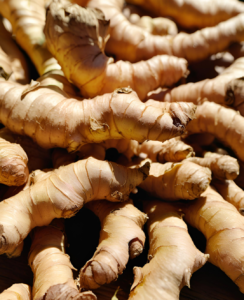Planting ginger in a pot or garden is one of the best ways to ensure a steady, endless supply of fresh ginger for your kitchen and wellness needs. This versatile root thrives in both small indoor pots and outdoor gardens, making it accessible to all gardeners. With the right care, soil, and growing conditions, you can enjoy homegrown ginger all year round. Pair it with other herbs for a diverse garden setup—try growing saffron in containers to complement your ginger plants
Choosing the Right Ginger Root
When planting ginger in a pot or garden, selecting healthy rhizomes is essential. Look for organic ginger roots with visible buds or “eyes.” These growth points indicate that the rhizome is ready to sprout. Avoid dried-out or shriveled roots, as they may struggle to grow. By choosing high-quality ginger, you set yourself up for a productive harvest.
- Pro tip: If you want to maximize your garden’s variety, try incorporating ginger alongside other spice plants like saffron. Check out how to grow saffron in containers to expand your herb garden.
Picking the Right Pot or Garden Spot

Ginger prefers wide, shallow containers that allow the rhizomes to spread horizontally. A 12-inch wide pot, at least 8-10 inches deep, works perfectly. For garden planting, choose a partially shaded location that offers morning sun but protects the plant from intense afternoon heat. Ginger can grow indoors too, provided it gets enough light.
Preparing Soil and Planting the Rhizomes
Soil Preparation
The right soil mix is crucial for success. Ginger needs loose, nutrient-rich, and well-draining soil with a slightly acidic pH of 5.5-6.5. When planting ginger in pots or your garden, ensure the “eyes” face upwards and cover them with 1-2 inches of soil. Water the soil thoroughly, but avoid overwatering, as ginger is prone to root rot. Proper soil preparation helps your ginger plants thrive, resulting in continuous, bountiful harvests
By following these steps, planting ginger in a pot or garden becomes a straightforward, rewarding gardening experience. With proper care and regular maintenance, you can enjoy an endless supply of ginger right at home.
Quick Planting Tips:
- Soak rhizomes overnight to stimulate sprouting.
- Plant with the eyes facing upwards and cover with 1-2 inches of soil.
For an eco-friendly approach, you might also consider burying organic material like fish scraps beneath the soil, which acts as a natural fertilizer. Learn more about the benefits of this technique by visiting how to bury fish scraps as fertilizer.
Optimal Growing Conditions
Ginger thrives under specific conditions:
- Temperature: Keep above 50°F (10°C).
- Light: Morning sun, afternoon shade.
- Humidity: Ideal between 70-90%; use a humidifier or pebble tray if needed.
Indoor plants should be placed near a bright window. If you plan to grow other herbs alongside your ginger, follow these companion planting tips to optimize space and resources.
Watering and Fertilizing Ginger
Ginger likes consistent moisture but not soggy soil. Water when the topsoil feels dry, usually once or twice a week. Overwatering can cause root rot, so ensure your pot has proper drainage.
For better results:
- Use a low-nitrogen fertilizer to promote rhizome growth.
- Apply organic manure or compost tea regularly to boost nutrient levels—learn how to make your own with manure tea for plants.
Managing Pests and Diseases
Ginger plants are generally pest-resistant, but some common threats include aphids, spider mites, and mealybugs. Use organic insecticides like neem oil or insecticidal soaps to manage infestations. Regularly inspect your plants and remove yellowing leaves to prevent fungal infections.
Harvesting Ginger for Endless Supplies
Ginger is ready to harvest after 8-10 months when the stems start to turn yellow. At this stage, reduce watering and allow the soil to dry before gently digging up the rhizomes. Save some pieces with visible “eyes” to replant and continue your endless ginger supply.
Preserving Your Ginger
To keep your harvested ginger fresh:
- Refrigerate unpeeled ginger for up to 1 month.
- Freeze peeled ginger for several months.
- Make ginger syrup or pickled ginger for extended shelf life—learn how to prepare it with this homemade pickled ginger guide.
Propagating Ginger for Next Season
To keep your ginger supply going, use these propagation methods:
- Water Propagation: Place a rhizome piece in water until roots form.
- Paper Towel Method: Wrap in damp paper towels and store in a plastic bag until roots appear.
- Direct Sowing: Plant directly in pots or the garden for gradual growth.
Troubleshooting Common Issues
- Yellow leaves: Could indicate overwatering or poor drainage.
- No shoots: Ensure rhizomes are planted with eyes facing upwards.
- Slow growth: Maintain warm temperatures above 50°F (10°C) for optimal development.
FAQs
How long does ginger take to grow?
Ginger typically takes 8-10 months to mature and may take up to 3 years to flower.
Can ginger grow indoors?
Yes, ginger can grow indoors as long as it receives adequate light and warmth.
What pests attack ginger?
Common pests include aphids, spider mites, and nematodes. Use organic pest management techniques for control.
Can store-bought ginger be planted?
Yes, just ensure the root has visible “eyes” and soak it before planting.
Conclusion
Growing ginger in pots or your garden is a rewarding endeavor that ensures a continuous supply of fresh rhizomes. By following these simple steps—from soil preparation to harvest and propagation—you can enjoy endless harvests at home. Alongside your ginger plants, why not explore growing other root vegetables like potatoes to expand your home garden even further?
With proper care and attention, your ginger plants will thrive and provide you with flavorful, organic produce year-round. Happy gardening!
